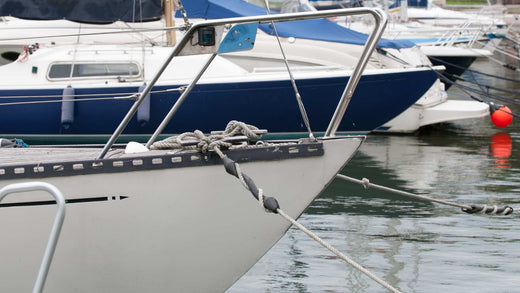
Dock Line Size Chart Guide: Choosing the Right Lines for Your Boat
Nicholas HeislerShare
When it comes to docking your boat, having the correct dock lines is essential for ensuring your vessel is secure and protected. Dock lines come in various sizes, and selecting the right one depends on your boat's length and the conditions in which you'll be docking. In this guide, we'll help you determine the right dock line size for your boat, explain the importance of tensile strength, and provide a handy dock line size chart for quick reference.
Table of Contents
- Why Dock Line Size Matters
- Understanding Dock Line Tensile Strength
- Dock Line Material: A Quick Overview
- Dock Line Size Chart
- Choosing the Right Line Length
- Docking Environment Considerations
- Maintenance and Care for Dock Lines
Why Dock Line Size Matters
The size of your dock lines is crucial because it directly affects the security of your boat at the dock. Too small, and the lines may snap under strain, especially in rough weather or high tidal conditions. Too large, and they may be cumbersome to handle and unnecessarily heavy. Properly sized dock lines not only hold your boat securely but also protect it from damage caused by sudden movements due to wind, waves, or passing boats.
Understanding Dock Line Tensile Strength
Tensile strength is the maximum load that a dock line can handle before breaking. It's measured in pounds and is a key factor when choosing the right dock line. The tensile strength required depends on your boat's size and weight, as well as the docking environment. Larger boats and harsher conditions will require lines with higher tensile strength to ensure safety.
Dock Line Material: A Quick Overview
Dock lines are typically made from three main materials:
- Nylon: The most popular choice due to its strength, elasticity, and resistance to abrasion and UV damage. Nylon lines can stretch, which is beneficial in absorbing shock loads.
- Polyester: Offers less stretch than nylon, making it a good choice for applications where minimal give is desired. It's also resistant to UV rays and abrasion.
- Polypropylene: Often used for temporary or emergency lines, polypropylene is lightweight and floats on water. However, it has lower tensile strength and UV resistance compared to nylon and polyester.
Dock Line Size Chart
To help you choose the right dock lines for your boat, use the chart below as a guide. It provides recommended dock line sizes based on boat length, along with the approximate tensile strength for each size.
| Boat Length | Line Size | Approx. Tensile Strength (lbs) |
|---|---|---|
| Up to 20ft | 3/8" | 4,200 |
| 20ft - 30ft | 1/2" | 7,400 |
| 30ft - 40ft | 5/8" | 14,800 |
| 40ft - 70ft | 3/4" | 19,000 |
| 70ft - 90ft | 7/8" | 28,300 |
| 90ft - 110ft | 1" | 33,500 |
| 110ft - 130ft | 1-1/8" | 44,900 |
| 130ft - 150ft | 1-1/4" | 54,300 |
| 150ft - 180ft | 1-1/2" | 74,000 |
Shop Common Dock Line Sizes:
Choosing the Right Line Length
In addition to diameter and tensile strength, dock line length is another critical factor. As a rule of thumb, bow and stern lines should be at least 1.5 to 2 times the boat's length. Spring lines, which run diagonally from the boat to the dock, should be 2.5 to 3 times the boat's length.
Docking Environment Considerations
When choosing dock lines, consider the environment where you'll be docking most often:
- Protected Waters: If you're docking in calm, protected waters, you may opt for slightly smaller lines, as the conditions will place less strain on the lines. Learn more about no wake speed zones.
- Open Waters or Tidal Areas: In harsher conditions, such as open waters or areas with significant tidal shifts, choose lines on the larger side of the recommended range to handle the increased stress.
Maintenance and Care for Dock Lines
Proper care of your dock lines will extend their lifespan and maintain their strength:
- Rinse with Fresh Water: After exposure to saltwater, rinse your dock lines with fresh water to remove salt and prevent degradation.
- Inspect Regularly: Check your lines for signs of wear, fraying, or damage. Replace any lines that show significant wear or have lost elasticity.
- Store Properly: When not in use, store your dock lines in a dry, shaded area to protect them from UV damage and moisture.
Conclusion
Choosing the right dock line size is crucial for the safety and security of your boat. By using the chart provided and considering factors like tensile strength, material, and docking environment, you can ensure your boat is always properly secured. Remember, maintaining your dock lines is just as important as choosing the right ones, so inspect and care for them regularly to keep your boat safe on the water.
For more tips on docking your boat, check out our guide on How to Tie Dock Lines. Safe boating!
Related Posts You May be Interested in:
- Mastering the Art of Docking
- How to Tie Essential Boat Knots
- Best Practices to Avoid Overloading Your Boat
When it comes to keeping your boat clean, look to Captains Preferred Products boat cleaning supplies. Find everything you need to keep your vessel squeaky clean all season - always at the best prices.




